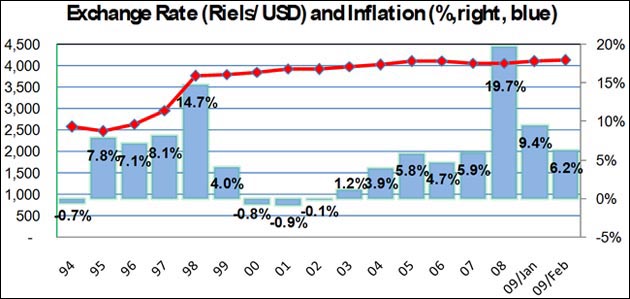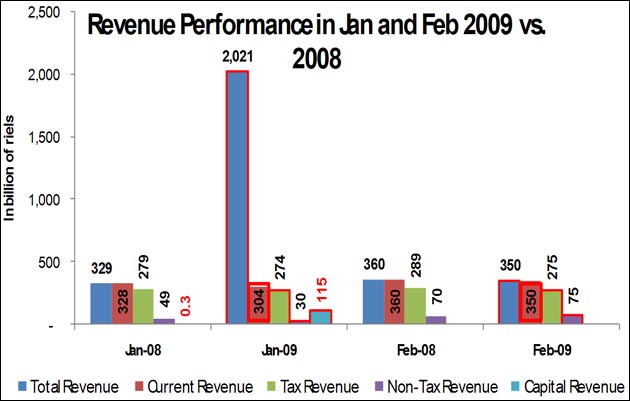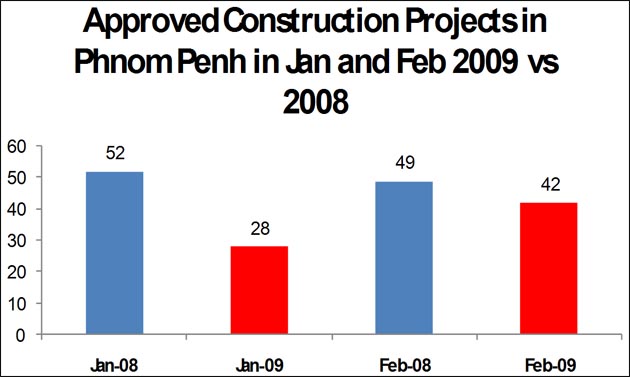|
|
Part I. Macroeconomic Development
(Bhrama) |
|
Economic
Conditions in 2009
-
G7 Finance Ministers and Central
bankers said that economic activity should begin to recover later
this year;
-
IMF
predicts slow recovery, no growth in 2010;
-
Growth
projection for Cambodia ranged from 6% to -1%;
-
Inflation
has reduced further in 2009 and recorded at 9.4% in Jan and 6.2%
in Feb, y-o-y.
-
The RGC is
committed to maintain 2009 budget and protect social spending,
health and education.
|
|
Exchange
rate is stable while inflation subsided

- In 2008 inflation hit highest since 1994
due to soaring food price and oil price and depreciation of dollar
against currencies of Cambodia’s trading partners, however USD/Riels
exchange rate remains stable.
|
|

- Total revenue in Jan-Feb 2009 increased by
3.4 times, compared to 2008 due to high capital revenue; current
revenue dropped by 5%.
|
|
Garment exports are slowing down

|
|

-
Construction
approval, in number of projects, dropped by 44% in Jan-Feb 2009,
compared to Jan-Feb 2008
|
|
Decline in the growth of M2

|
|
Banking Sector—Liquidity

-
Liquidity dropped by -1.6% in
Sept and -5.4% in October, -2.7% in Nov, but increased by 2.5% in
Dec; foreign currency deposits dropped by -2.2 in Sept, -5.4% in
Oct, -3.3% in Nov, but increased by 1% in Dec, while credit to the
private sector continues to grow by 1.6% in Sept and 1.7% in Oct,
but declined by -0.6% in Nov. In December 2008, credit to the
private sector increased by 0.1%.
|
|
Part II. Policy Options
And
Response Measures |
|
Impacts 1/ |
| A major
slowdown of growth, with an accelerator effect on investment
(already weak and dependent on foreign inflows), export,
tourism. This was caused by external (e.g. a deeper global
recession), and could have feed-back loop on banking sector. |
|
Policy Responses |
|
Create fiscal space |
-
Revenue
mobilization by further strengthen tax administration:
strict measures to recover arrears;
-
The Ministry
of Economy and Finance and all relevant Ministries continue
to mobilize all kinds of revenues in order to meet the
objectives set in the 2009 Budget Law; and
-
Rationalizing expenditure: transfer savings from current
budget to increase investment in high priority areas,
including social safety nets and productivity, transport,
irrigation;
-
Increase
domestic financing, using government bank deposits and
non-bank financing;
-
Increase ODA
disbursements;
|
|
|
Impacts 1/ |
| A major
slowdown of growth, with an accelerator effect on investment
(already weak and dependent on foreign inflows), export,
tourism. This was caused by external (e.g. a deeper global
recession), and could have feed-back loop on banking sector. |
|
Policy Responses 2/ |
|
Improve monitoring |
-
Institutional monitoring: using existing mechanism at
Ministries and agencies to monitor socio-economic
consequences of the crisis;
-
Monitoring
of disbursement: for ADB and WB projects, the MEF will focus
on a monthly report on disbursement;
-
Monitoring
of disbursement: for other projects, quarterly report would
be appreciated; this could improve the quarterly GDP
forecast;
-
For fiscal
issues: TOFE;
-
For monetary
issues: Monetary Survey of NBC;
|
|
|
Impacts 1/ |
| A major
slowdown of growth, with an accelerator effect on investment
(already weak and dependent on foreign inflows), export,
tourism. This was caused by external (e.g. a deeper global
recession), and could have feed-back loop on banking sector. |
|
Policy Responses |
| Relax
monetary policies |
-
Decreased
the reserve requirement to 12%;
-
Remove
credit ceiling on commercial bank credit to the real estate
sector;
-
Enhancing
capital base though the increase in minimum capital
requirement; and
-
Create
overdraft facility to support commercial bank;
-
Further
loosening monetary policy should conditions warrant;
|
|
|
Impacts 2/ |
| Domestic
financial sector vulnerability, from a simple loss of trust in
the financial sector or from a rapid deterioration of asset
quality (either because current risks were underestimated or
misreported, or through a slow-down of the economy or a fall
in property prices). |
|
Policy Responses |
|
Strengthen banking regulations/supervision (with specific
actions as follows) |
-
Improving
classification of banks assets and provisioning;
-
Improving
the valuation of collateral used for bank lending;
-
Further
strengthen the banking system through rigorous
implementation of on-site and off-site inspections and
supervision;
-
Strengthen
credit information sharing system;
-
Strengthen
the system for implementing reserve requirements;
-
Improve
banks internal and external auditing;
-
Strengthening bank liquidity management; and
-
Strengthen
corporate governance of banks and financial institutions.
|
|
|
Impacts 3/ |
| A sudden
stop or reversal of capital inflows, with a magnified impact
in a dollarized economy. This could also trigger difficulties
in financing the current account deficit. |
|
Policy Responses |
|
Adjust policy mix (depending on risk of slower growth), mainly
through fiscal policy (accelerate revenue growth while
containing spending), with support from monetary policy,
especially exchange rate flexibility. (with specific
actions as follows) |
-
Improve the
investment climate (to mitigate the risk of a drastic
slowdown in trade and FDI);
-
Flexibility
of the exchange rate;
-
Encourage
domestic savings; and
-
Continue
mobilization of external assistance.
|
|
|
Impacts 4/ |
| Growth
slowdown in light of drop in commodity prices including the
price of rice and paddy; and the decline in both domestic and
external demand in key sectors. |
|
Policy Responses 1/ |
|
Agriculture intervention (with specific actions as
follows) |
-
Create
Agriculture Support and Development Fund of US$18 million;
-
Zero tariff
on importing agriculture materials such as seeds,
fertilizers, pesticide and agricultural equipments etc.; and
-
Streamlining
procedures and 3 years tax holiday for agricultural
investment projects.
-
Planned
further incentives for investment in processing facilities,
rice milling for exports and investment in irrigation;
-
Streamlined
procedures to promote rice exports;
-
Promoting
farmer organization by setting up cooperatives;
-
Seeds,
fertilizers, agricultural extension, marketing;
|
|
|
Impacts 4/ (cont…) |
| Growth
slowdown in light of the lack of external demand for Cambodian
garment products |
|
Policy Responses 2/ |
|
Garment sector intervention (with specific actions as
follows) |
-
Fiscal
measure: suspension of 1% pre-payment of tax on profit;
-
Special fund
for training program;
-
trade
financing/credit (yet to put in place);
-
Promotion of
supporting industries (product clusters);
-
Improvement
in labor standard, dispute resolution and better relation
between employers and employees with collaboration from
trade unions; and
-
Diversifying
the markets for our garments and other manufactured goods.
|
|
|
Impacts 4/ (cont…) |
| Growth
slowdown in light of the GFC and reduction in tourists
visiting Cambodia. |
|
Policy Responses 3/ |
|
Tourism sector intervention (with specific actions as
follows) |
-
Ensuring
peace, security, political stability, social order and
tourist safety;
-
Building
more tourism infrastructures;
-
Improving
legal framework and institutional capacity;
-
Developing
human resources; and
-
Diversifying
tourist market/destinations and attractive tour packages;
-
Visa fee
waiver could be promoted if this can help;
|
|
|
Impacts 4/ (cont…) |
| Growth
slowdown in light of the GFC and slowdown in investment. |
|
Policy Responses 4/ |
|
Structural Reforms (with specific actions as follows) |
-
Improve
trade facilitation through customs computerization ASYCUDA;
-
Streamlining
procedures to reduce formal and informal costs;
-
Acceleration
of adoption of laws and legislation and their enforcement in
various sectors as part of wider institutional reforms:
support from the National Assembly and Senate is required;
-
Relaxed
procedures are needed at the Council of Ministers to speed
up approval of legal framework by removing the bottlenecks
(although quality benchmarks should be maintained);
-
Frequent
meetings of the Committee on Economic and Financial Policies
to discuss with the private sectors and related parties on
policy responses.
|
|
|
Impacts 5/ (cont…) |
| Growth
slowdown leading to increase in unemployment. |
|
Policy Responses 5/ |
|
Competitiveness and training |
-
Provide
funds of US$6.5 million for short-term scholarship programs
to train some 40,000 workers in agriculture, industry,
handicraft and services;
-
Earmark US$1
million to establish “Fund for Self-Employment” to be
managed by the National Employment Agency to provide
micro-finance to help trained workers to set up their small
businesses;
-
Medium to
long-term reform would be required to increase
competitiveness: electricity, transport, port handling,
customs clearance, reduced inspection, but improved risk
management etc.
|
|
|
Impacts 5/
|
|
Poor and vulnerable groups affected by the
crisis. |
|
Policy Responses |
|
Social safety net |
The rural sector acts
as an informal social safety net in Cambodia |
-
Health
Equity Fund;
-
Food
Emergency Program;
-
Food for
work (WFP) and Mother and Child Health program (WFP);
-
School
feeding programs;
Targeted scholarship programs for secondary education
students;
-
Operationalize the National Social Security Fund; and
-
Pre-paid
health insurance scheme.
|
|
|
|
Thank You
(Churning of the Ocean
of Milk) |
|


